Cyclic p-y Curves of Monopiles in Dense Dry Sand Using Centrifuge Model Tests
Abstract
:1. Introduction
2. Centrifuge Model Test
2.1. Soil Properties and Pile Information
2.2. Static Loading Test
2.3. Cyclic Loading Test
3. Centrifuge Model Test Results
3.1. Selecting the Ultimate Load
3.2. The p-y Curve Creation Method
3.3. Experimental Static p-y Curve Results
3.4. Experimental Cyclic p-y Curve Results
4. Cyclic p-y Backbone Curve for Dry Sand
4.1. Ultimate Soil Resistance (pu)
4.2. Initial Modulus of Subgrade Reaction (kini)
4.3. Suggested Cyclic p-y Curve
5. Comparison with Existing p-y Curves
6. Conclusions
- (1)
- The first cycle cyclic p-y curve showed tendencies that were similar to the static p-y curve. As the number of cycles increased, the initial slope and soil resistance increased. This was found to be due to a phenomenon in which nearby soil filled the gap between the pile and the sand and became denser due to cyclic loading;
- (2)
- The cyclic p-y backbone curve followed the increase in the number of cycles. It tended to increase from the first to the 90th cycle and converge from the 90th to the 100th cycle. This was found to be an effect of the initial number of cycles on the cyclic p-y curve;
- (3)
- The initial modulus of subgrade reaction was assumed to increase nonlinearly, according to depth, and a regression analysis was performed on it to find the modulus of subgrade reaction. The results showed that the modulus of subgrade reaction after the first cycle was 6228 kN/m3, and the modulus of subgrade reaction after the 100th cycle was 10,313.4 kN/m3;
- (4)
- As for the maximum soil resistance, the suggested cyclic p-y curve was greater than the API p-y curve [8]. However, in the API p-y curve, the soil resistance converged at a pile displacement of 10–15 mm, while in the suggested cyclic p-y curve, the soil resistance showed a tendency to gradually increase according to an increase in the pile displacement;
- (5)
- The upper and lower limit of the cyclic p-y curve according to the number of cycles was found. The shape of the cyclic p-y curve varies from the first to the 100th cycle; therefore, further research on this phenomenon is necessary when short-term behavior is considered;
Author Contributions
Acknowledgments
Conflicts of Interest
References
- Achmus, M.; Kuo, Y.-S.; Abdel-Rahman, K. Behavior of monopile foundations under cyclic lateral load. Comput. Geotech. 2009, 36, 725–735. [Google Scholar] [CrossRef]
- Møller, I.F.; Christiansen, T. Laterally Loaded Monopile in Dry and Saturated Sand—Static and Cyclic Loading; Aalborg University: Aalborg, Denmark, 2011. [Google Scholar]
- Kim, K.; Nam, B.H.; Youn, H. Effect of Cyclic Loading on the Lateral Behavior of Offshore Monopiles Using the Strain Wedge Model. Math. Probl. Eng. 2015, 2015, 1–12. [Google Scholar] [CrossRef]
- Peralta, P. Investigations on the Behavior of Large Diameter Piles under Long-Term Lateral Cyclic Loading in Cohesionless Soil. Ph.D. Thesis, Leibniz University, Hannover, Germany, 2010. [Google Scholar]
- Roesen, H.R.; Ibsen, L.B.; Andersen, L.V. Small-Scale Testing Rig for Long-Term Cyclically Loaded Monopiles in Cohesionless Soil. In Proceedings of the Nordic Geotechnical Meeting Nordic Geotechnical Meeting, Copenhagen, Denmark, 9–12 May 2012; pp. 435–442. [Google Scholar]
- Gerber, T.M.; Rollins, K.M. Cyclic P-Y Curves for a Pile in Cohesive Soil. In Geotechnical Earthquake Engineering and Soil Dynamics Congress IV; ASCE: Sacramento, CA, USA, 2008; pp. 1–10. [Google Scholar]
- Fan, C.-C.; Long, J.H. Assessment of existing methods for predicting soil response of laterally loaded piles in sand. Comput. Geotech. 2005, 32, 274–289. [Google Scholar] [CrossRef]
- American Petroleum Institute. Recommended Practice for Planning, Designing, and Constructing Fixed Offshore Platforms; American Petroleum Institute: Washington, DC, USA, 1987. [Google Scholar]
- Matlock, H. Correlations for Design of Laterally Loaded Piles in Soft Clay. In Offshore Technology in Civil Engineering’s Hall of Fame Papers from the Early Years; ASCE: Sacramento, CA, USA, 1970; Volume 1, pp. 77–94. [Google Scholar]
- Cox, W.R.; Reese, L.C.; Grubbs, B.R. Field Testing of Laterally Loaded Piles in Sand. In Proceedings of the Offshore Technology Conference, Houston, TX, USA, 6–8 May 1974. [Google Scholar]
- Reese, L.C.; Cox, W.R.; Koop, F.D. Analysis of Laterally Loaded Piles in Sand. 80OTC 1974, 2, 473–483. [Google Scholar]
- Brown, D.; O’Neill, M.; Hoit, M.; McVay, M.; El Naggar, M.; Chakraborty, S. Static and Dynamic Lateral Loading of Pile Groups. NCHRP Report 461. National Cooperative Highway Research Board. In Transportation Research Board, National Research Council; Transportation Research Board: Washington, DC, USA, 2001. [Google Scholar]
- Choo, Y.W.; Kim, D.W. Experimental Development of the P-Y Relationship for Large-Diameter Offshore Monopiles in Sands: Centrifuge Tests. J. Geotech. Geoenvironmental Eng. 2015, 142, 04015058. [Google Scholar] [CrossRef]
- Li, Z.; Haigh, S.; Bolton, M. Centrifuge modelling of mono-pile under cyclic lateral loads. Phys. Model. Geotech. Two Vol. Set 2010, 2, 965–970. [Google Scholar]
- Yoo, M.-T.; Choi, J.-I.; Han, J.-T.; Kim, M.-M. Dynamic P-Y Curves for Dry Sand from Centrifuge Tests. J. Earthq. Eng. 2013, 17, 1082–1102. [Google Scholar] [CrossRef]
- ASTM D2487-11. Standard Practice for Classification of Soils for Engineering Purposes (Unified Soil Classification System); ASTM International: West Conshohocken, PA, USA, 2011. [Google Scholar]
- Ovesen, N. The Use of Physical Models in Design. In Proceedings of the 7th European Conference on Soil Mechanics and Foundation Engineering, Brighton, UK, 10–13 September 1979; Volume 4, pp. 319–323. [Google Scholar]
- Broms, B.B. Lateral Resistance of Piles in Cohesionless Soils. J. Soil Mech. Found. Div. 1964, 90, 123–158. [Google Scholar]
- Remaud, D. Pieux Sous Charges Latérales: Etude Expérimentale De L’effet De Groupe. Ph.D. Thesis, Ecole Centale de Nantes, Nantes, France, 1999. (In French). [Google Scholar]
- Suits, L.D.; Sheahan, T.; Peng, J.; Clarke, B.; Rouainia, M. A Device to Cyclic Lateral Loaded Model Piles. Geotech. Test. J. 2006, 29, 100226. [Google Scholar] [CrossRef]
- Fleming, W.; Weltman, A.; Randolph, M.; Elson, W. Piling Engineering; Blackie Academic & Professional: Glasgow, UK, 1992. [Google Scholar]
- Dou, H.; Byrne, P.M. Dynamic response of single piles and soil pile interaction. Can. Geotech. J. 1996, 33, 80–96. [Google Scholar] [CrossRef]
- Qin, H.; Guo, W.D. Response of Static and Cyclic Laterally Loaded Rigid Piles in Sand. Mar. Georesources Geotechnol. 2016, 34, 138–153. [Google Scholar] [CrossRef]
- Rosquoët, F.; Thorel, L.; Garnier, J.; Canepa, Y. Lateral cyclic loading of sand-installed piles. Soils Found. 2007, 47, 821–832. [Google Scholar] [CrossRef]
- Ting, J.M.; Kauffman, C.R.; Lovicsek, M. Centrifuge static and dynamic lateral pile behaviour. Can. Geotech. J. 1987, 24, 198–207. [Google Scholar] [CrossRef]
- Yang, E.K.; Jeong, S.S.; Kim, J.H.; Kim, M.M. Dynamic Py Backbone Curves from 1g Shaking Table Tests. In Proceedings of the 88th Transport Res Board Annual Meeting, Washington, DC, USA, 11–15 January 2009; pp. 1–16. [Google Scholar]
- Kondner, R.L. Hyperbolic Stress-Strain Response: Cohesive Soils. J. Geotech. Eng. Div. 1963, 89, 115–143. [Google Scholar]
- Yoo, M.; Han, J.; Choi, J.; Jung, I.; Kim, M. Comparison of Lateral Pile Behavior under Static and Dynamic Loading by Centrifuge Tests. GeoCongress 2012, 2012, 2048–2057. [Google Scholar]
- Lee, M.; Yoo, M.; Bae, K.; Kim, Y.; Nam, B.H.; Youn, H. Centrifuge Tests on the Lateral Behavior of Offshore Monopile in Saturated Dense Sand under Cyclic Loading. J. Test. Evaluation 2018, 47. [Google Scholar] [CrossRef]
- Palmer, L.; Thompson, J. The Earth Pressure and Deflection Along the Embedded Lengths of Piles Subjected to Lateral Thrusts. In Proceedings of the 2nd Int. Conf. Soil Mech. and Found. Eng., Rotterdam, The Netherlands, 21–30 June 1948; Volume 5, pp. 156–161. [Google Scholar]
- Reese, L.; Matlock, H. Non-Dimensionnal Solutions for Laterally Loaded Piles in Sand, Paper No. 2080. In Proceedings of the 6th Annual Offshore Technology Conference, Houston, TX, USA, 6–8 May 1956; Volume 2. [Google Scholar]
- Ashford, S.A.; Juirnarongrit, T. Evaluation of Pile Diameter Effect on Initial Modulus of Subgrade Reaction. J. Geotech. Geoenvironm. Eng. 2003, 129, 234–242. [Google Scholar] [CrossRef]
- Barton, Y.; Finn, W.; Parry, R.; Towhata, I. Lateral Pile Response and p-y Curves from Centrifuge Tests. 80OTC 1983, 4502, 503–508. [Google Scholar]
- Finn, W.L.; Dowling, J. Modelling Effects of Pile Diameter. Can. Geotech. J. 2015, 53, 173–178. [Google Scholar] [CrossRef]

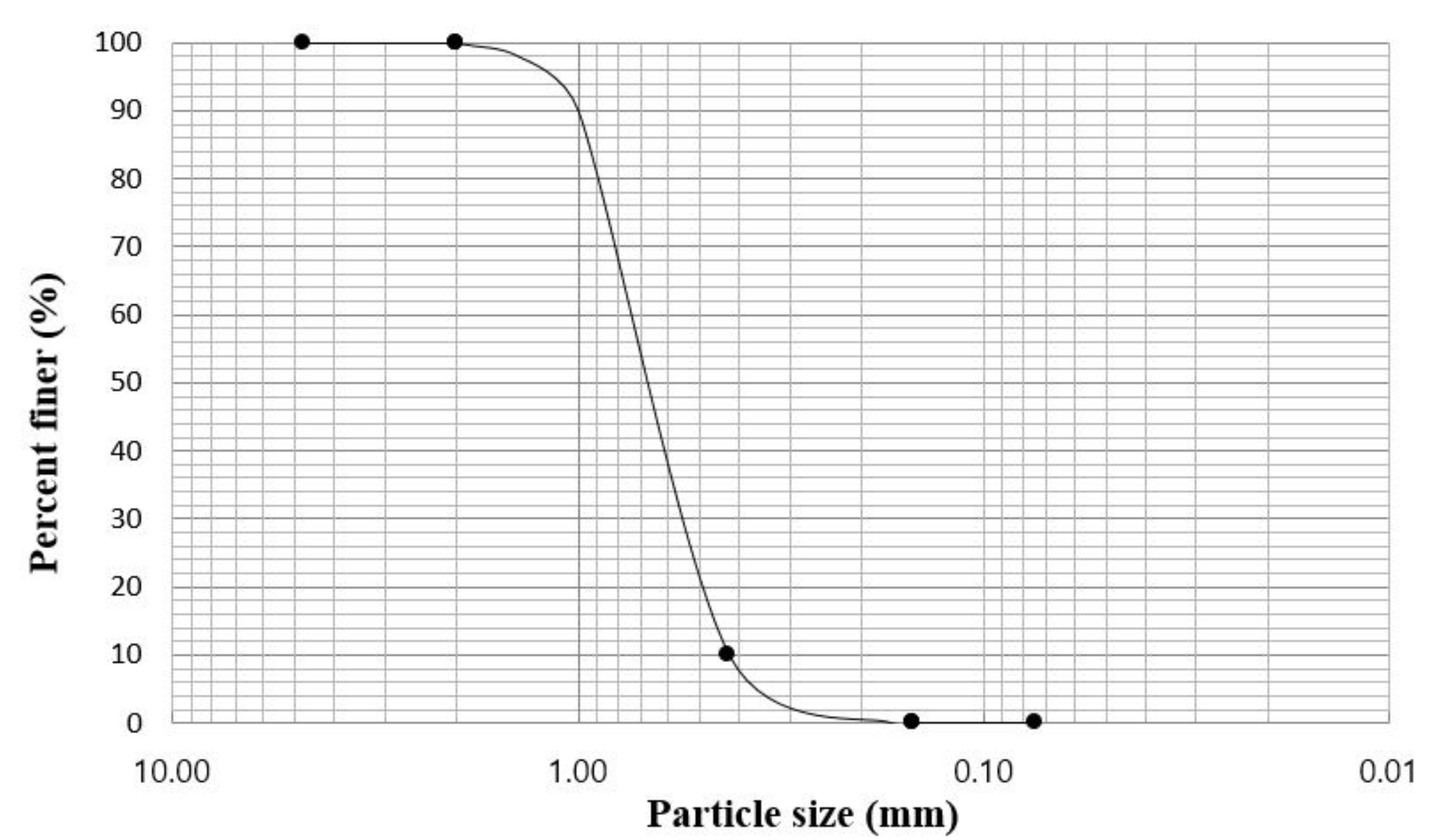
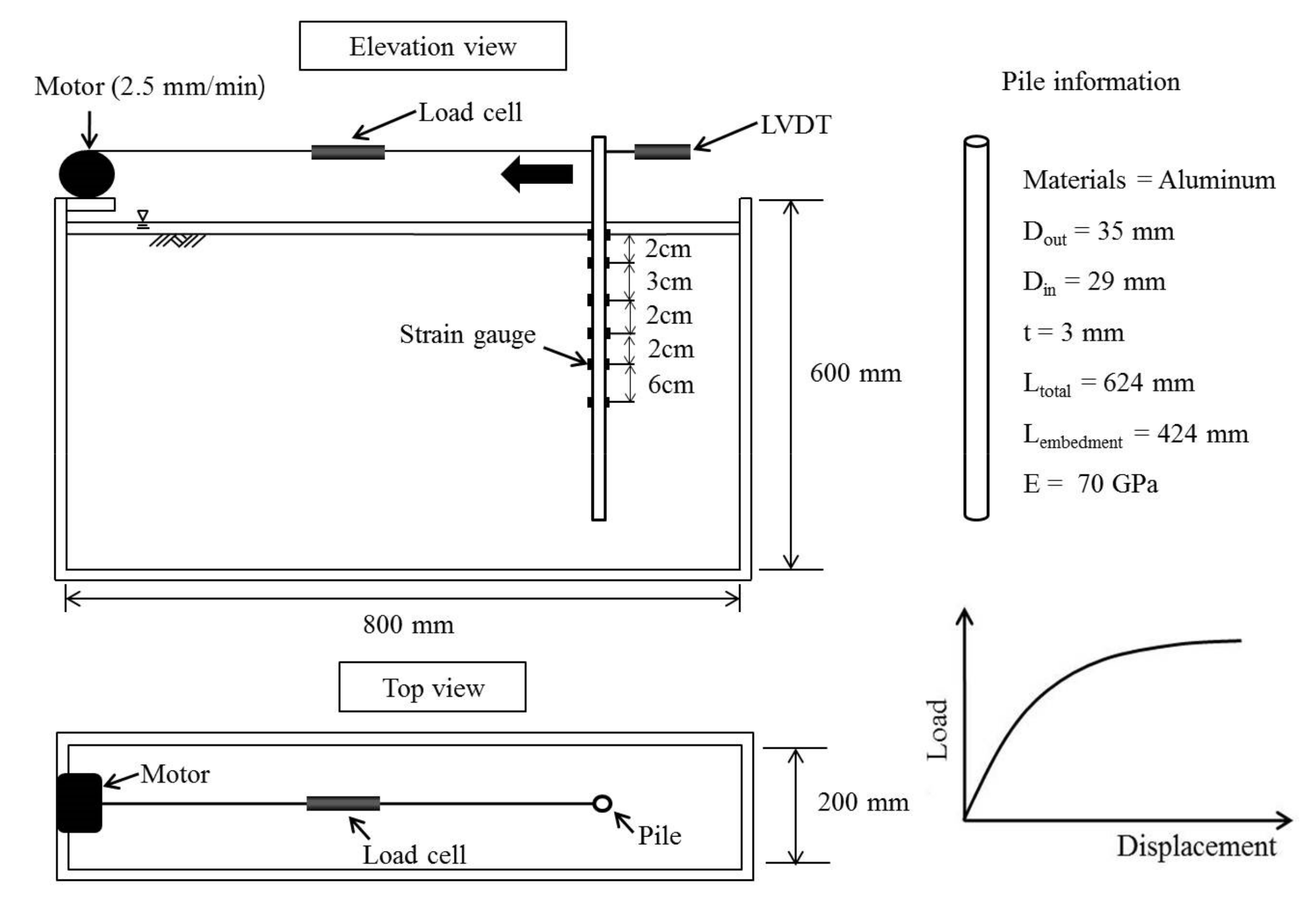
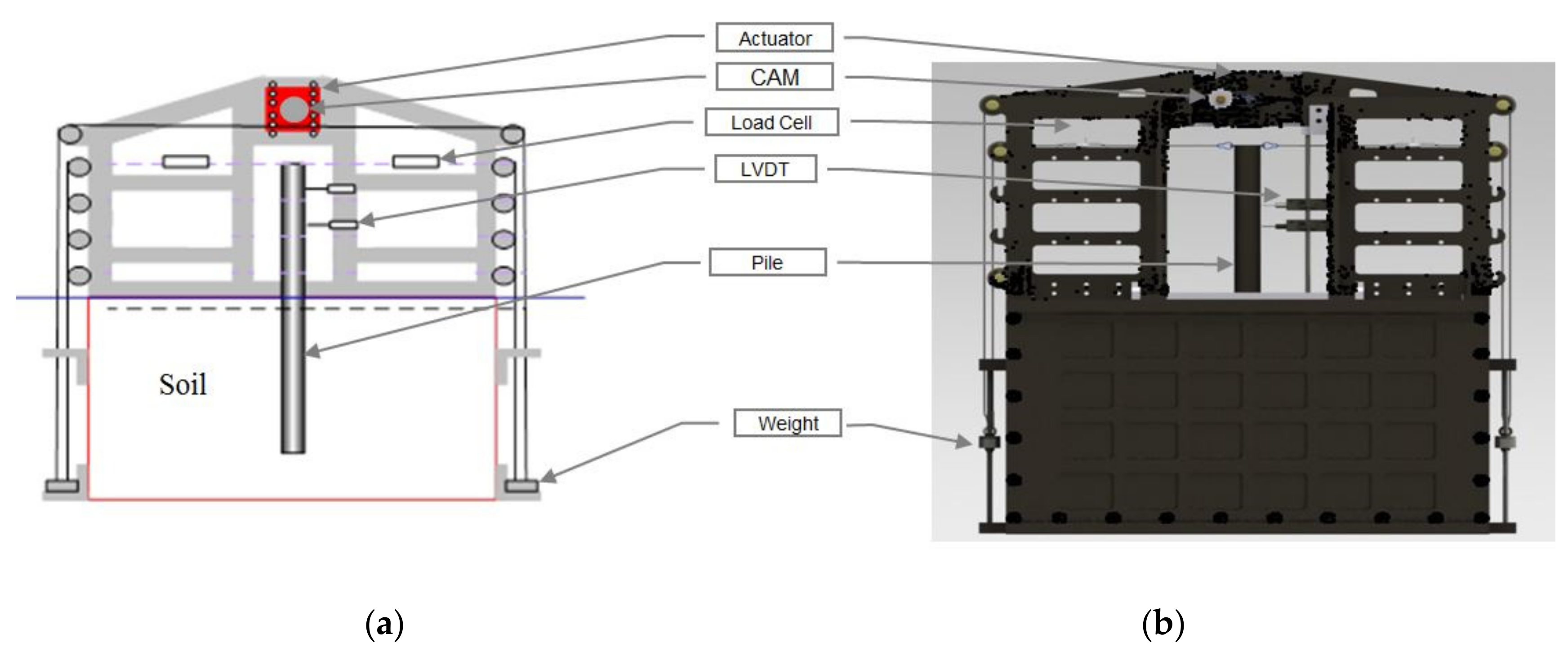
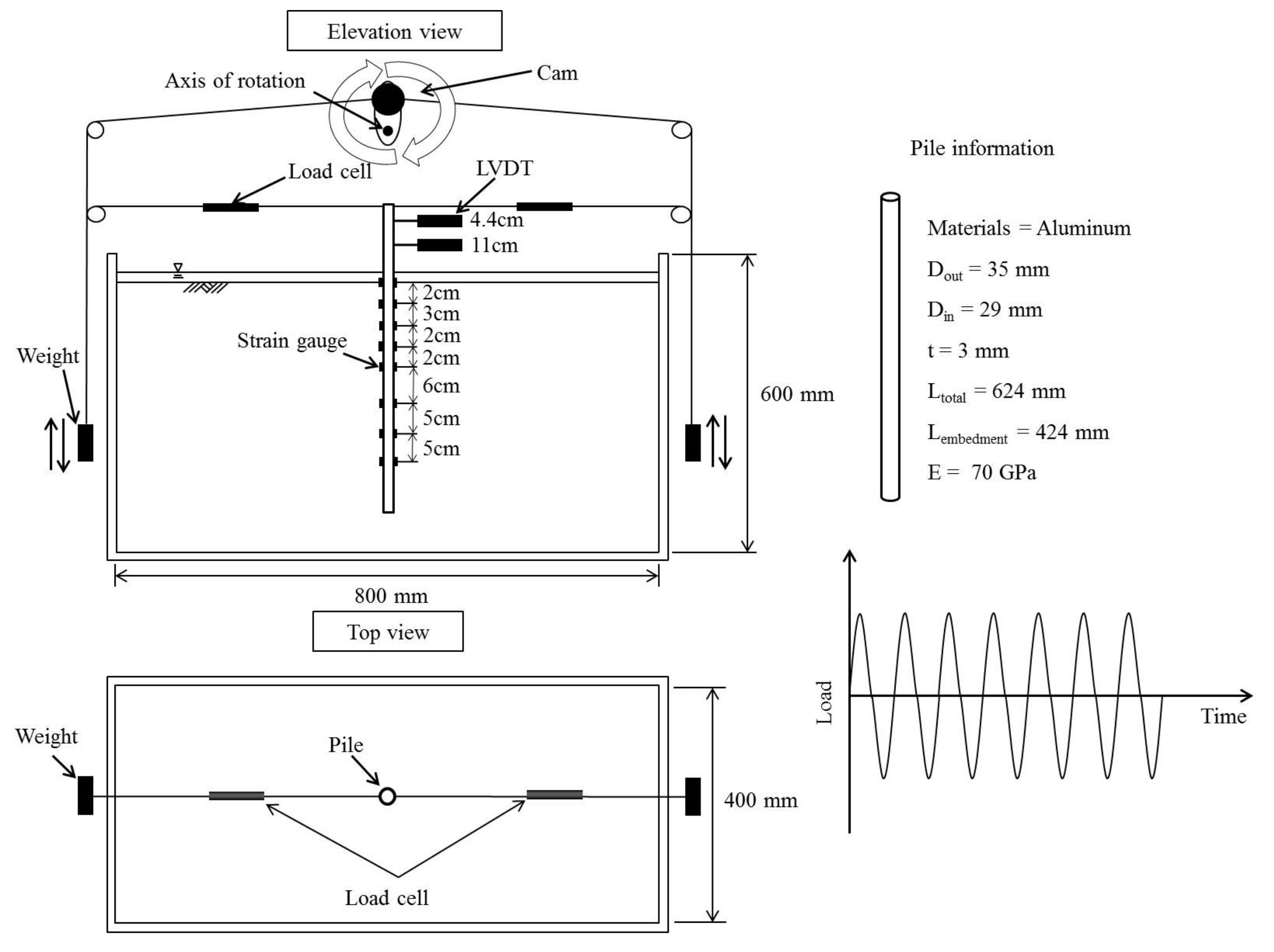


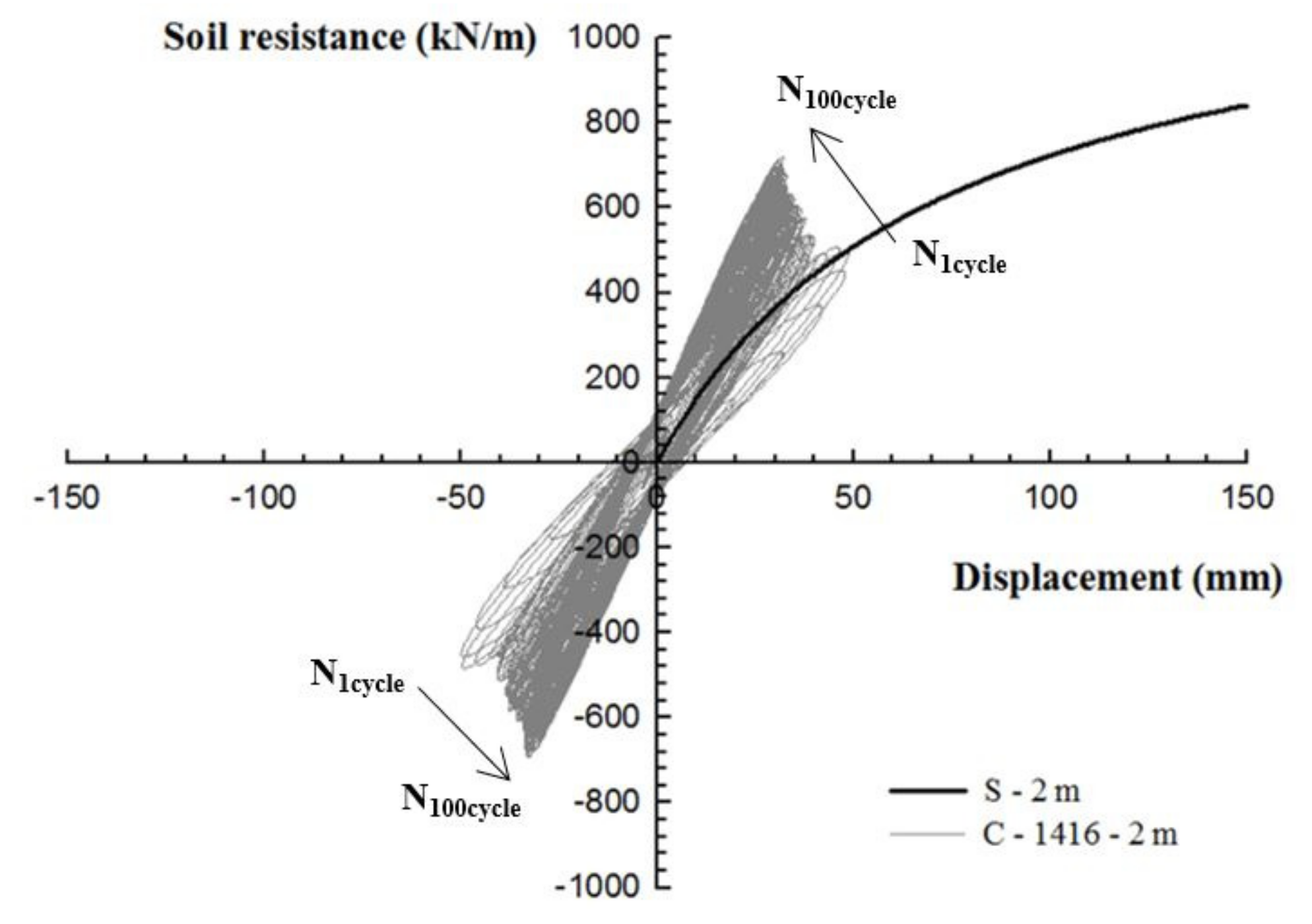
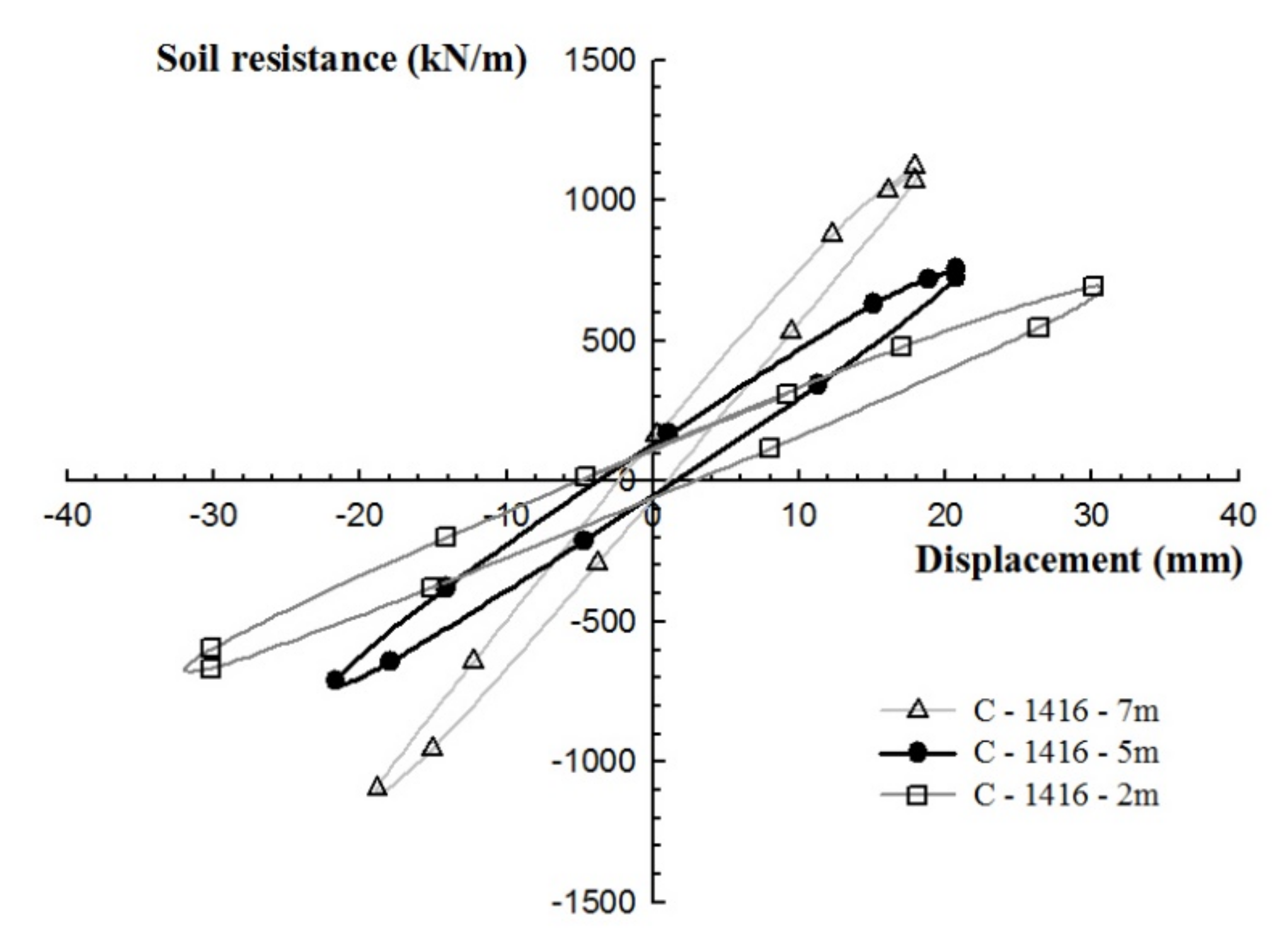
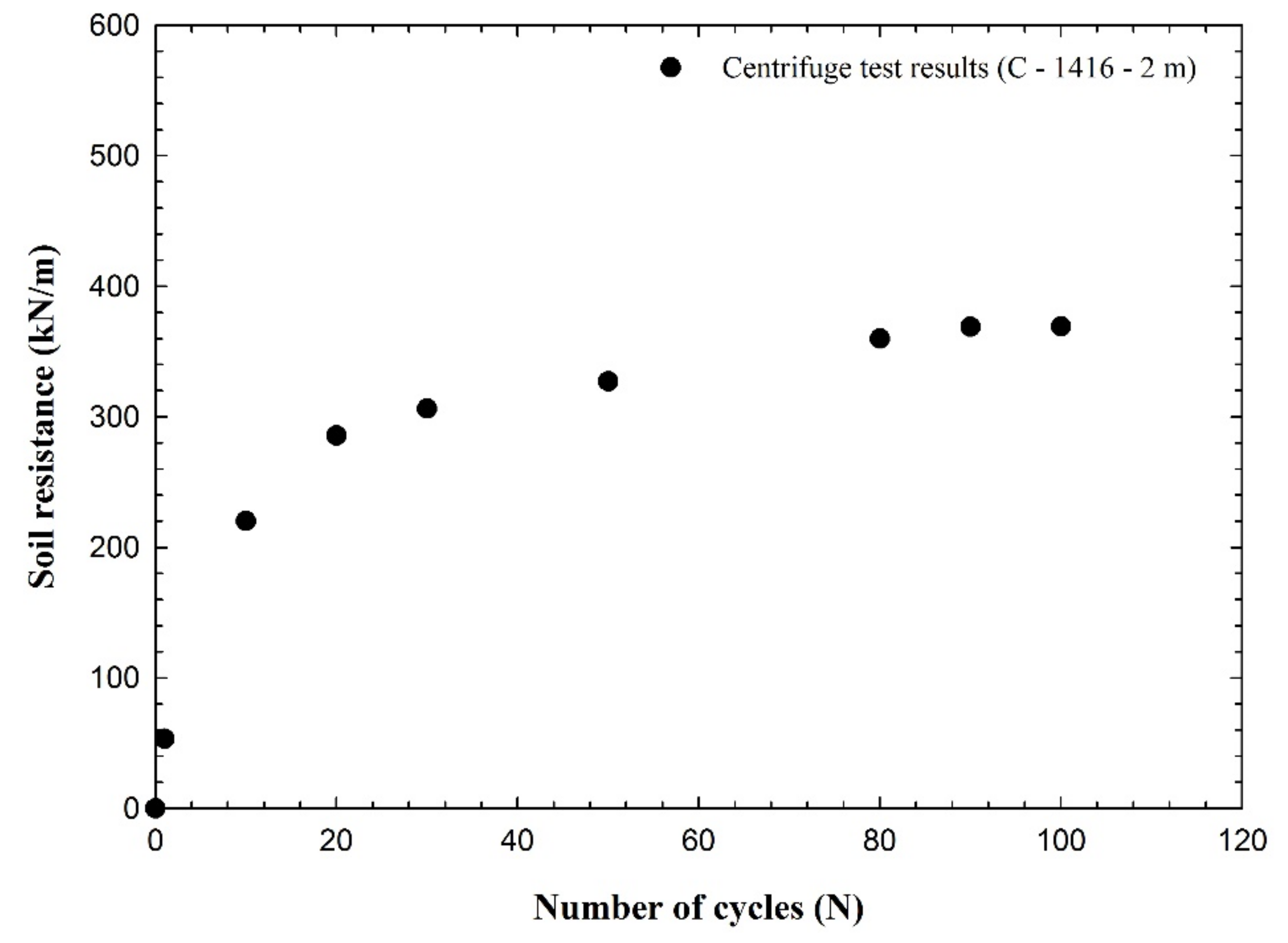
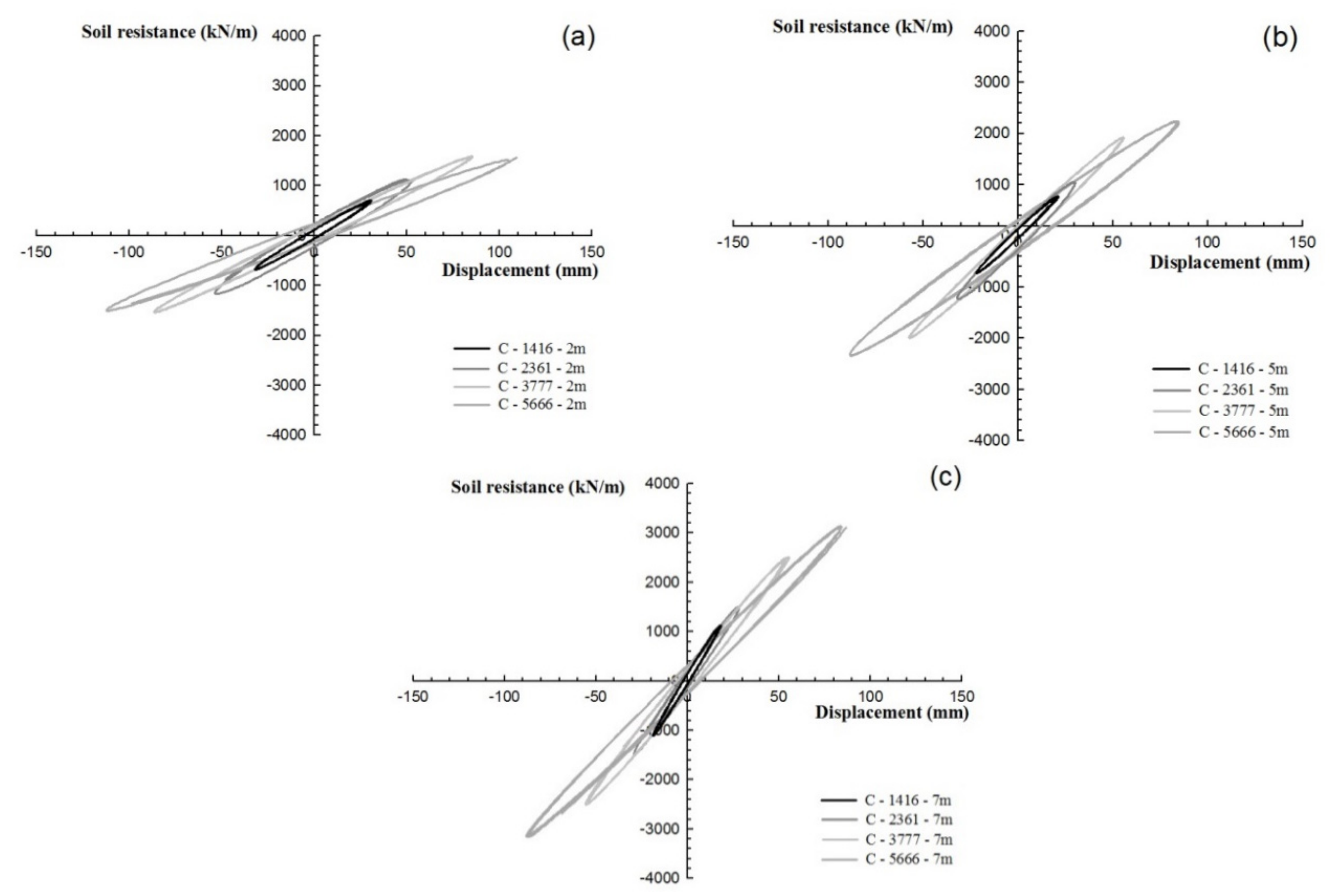
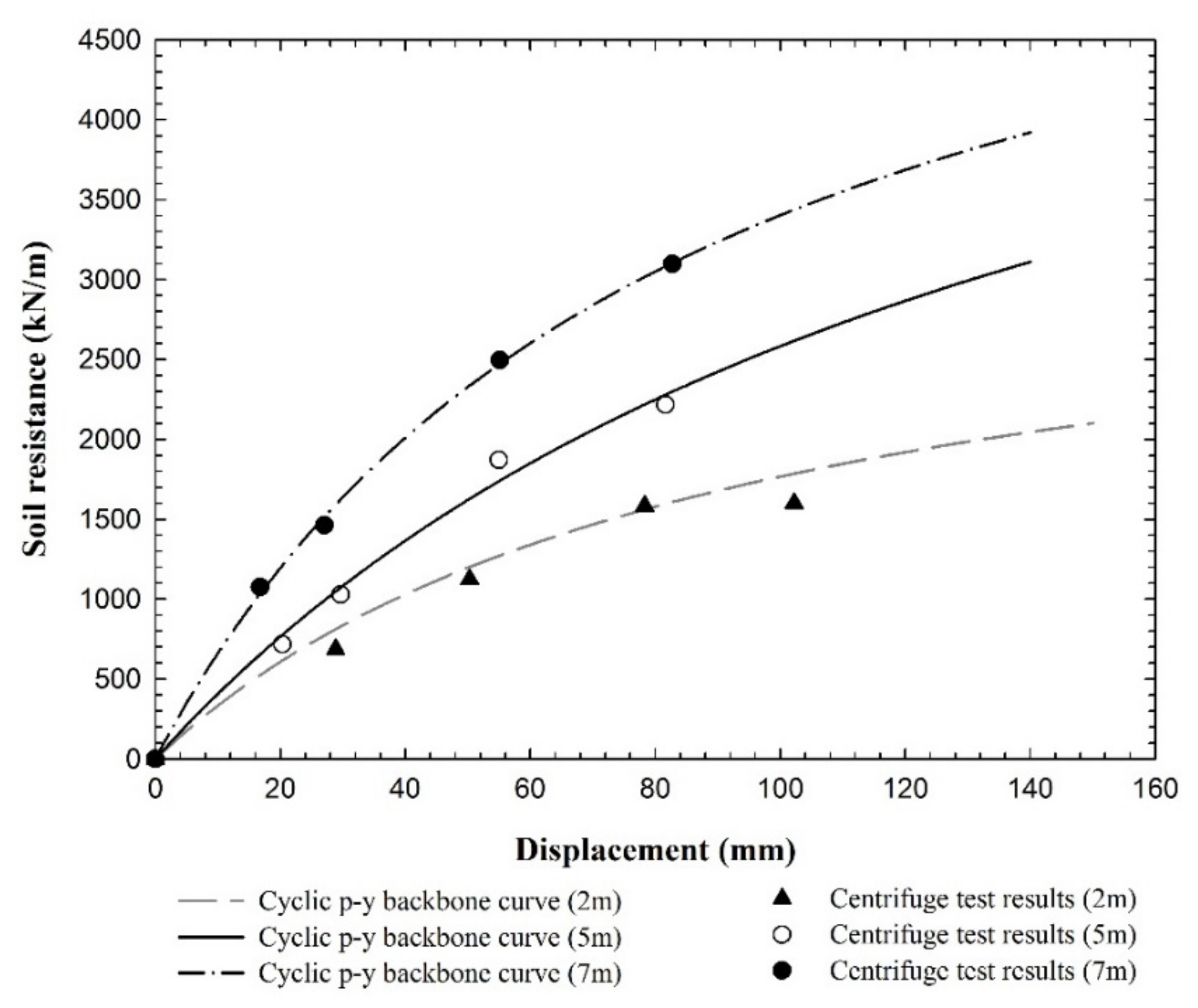
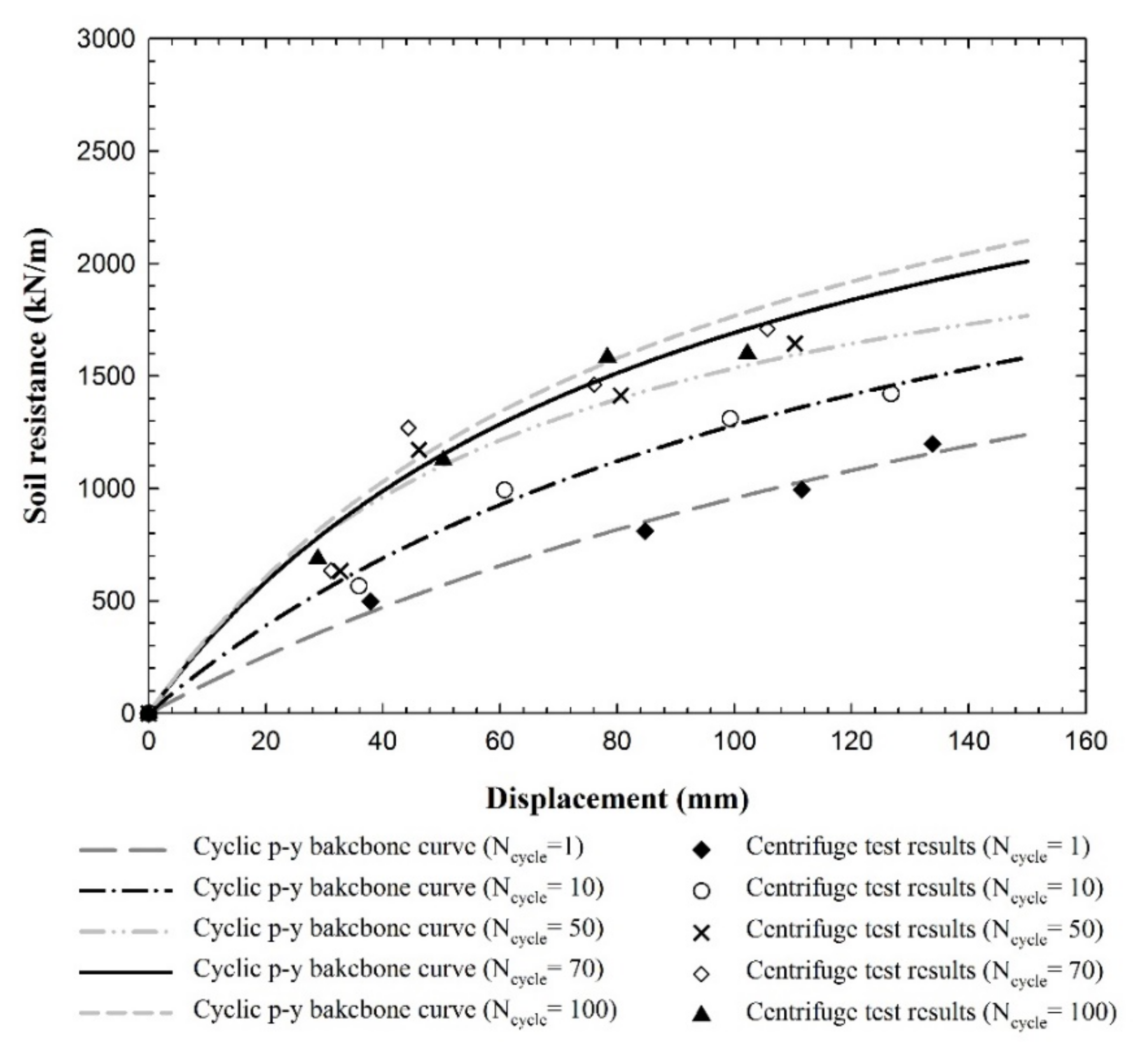



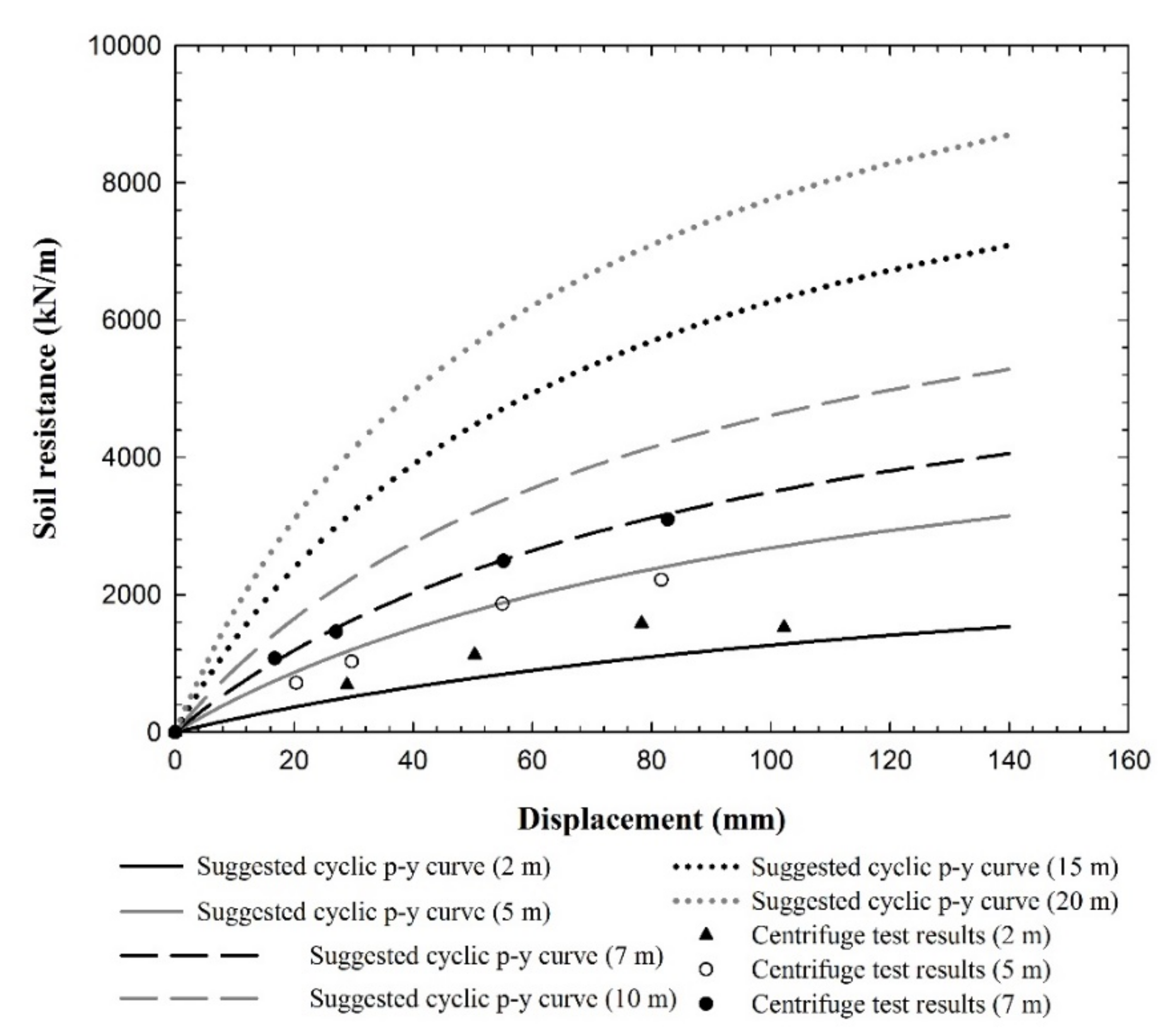
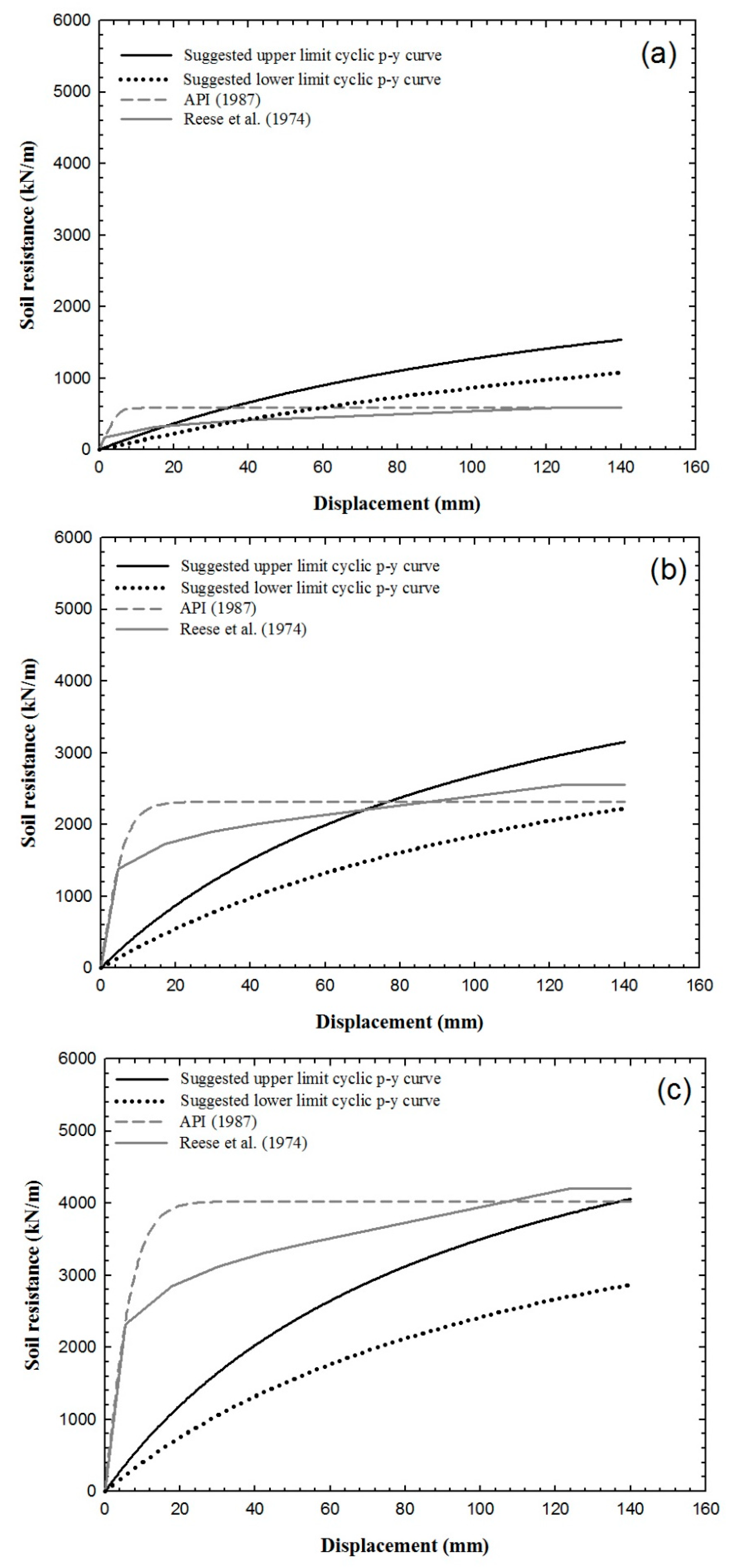
| USCS | SP |
|---|---|
| Maximum unit weight (kN/m3) | 16.6 |
| Minimum unit weight (kN/m3) | 13.3 |
| Coefficient of uniformity (Cu) | 1.68 |
| Specific gravity (Gs) | 2.65 |
| Relative density (%) | 80 |
| Friction angle | 38 |
| Model Pile | Scale Factor | Prototype Pile | |
|---|---|---|---|
| Material | Aluminum | n/a | Steel |
| Pile length (m) | 0.639 | λ | 60 |
| Embedment depth (m) | 0.424 | λ | 40 |
| Outer diameter (m) | 0.035 | λ | 3.3 |
| Elastic modulus (GPa) | 70 | 1 | 210 |
| Moment of Inertia (m4) | 3.89 × 10–8 | λ4 | 1.02 |
| Flexural rigidity (kN∙m2) | 2.73 | λ4 | 2.15 × 108 |
| Load (N) | 1.0 | λ | 8873.6 |
| Relative stiffness (-) | 2.04 × 10–4 | 1 | 2.07 × 10–4 |
| Case | Penetration Depth (mm) | Motor Speed (mm/min) | Relative Density (%) |
|---|---|---|---|
| S-80 | 424 | 2.5 | 80 |
| Case | Embedment Depth (mm) | Load (kN) | Frequency (Hz) | Relative Density (%) |
|---|---|---|---|---|
| C-1416 | 424 | 1416 | 0.125 | 80 |
| C-2361 | 2361 | |||
| C-3777 | 3777 | |||
| C-5666 | 5666 |
© 2019 by the authors. Licensee MDPI, Basel, Switzerland. This article is an open access article distributed under the terms and conditions of the Creative Commons Attribution (CC BY) license (http://creativecommons.org/licenses/by/4.0/).
Share and Cite
Lee, M.; Bae, K.-T.; Lee, I.-W.; Yoo, M. Cyclic p-y Curves of Monopiles in Dense Dry Sand Using Centrifuge Model Tests. Appl. Sci. 2019, 9, 1641. https://doi.org/10.3390/app9081641
Lee M, Bae K-T, Lee I-W, Yoo M. Cyclic p-y Curves of Monopiles in Dense Dry Sand Using Centrifuge Model Tests. Applied Sciences. 2019; 9(8):1641. https://doi.org/10.3390/app9081641
Chicago/Turabian StyleLee, Myungjae, Kyung-Tae Bae, Il-Wha Lee, and Mintaek Yoo. 2019. "Cyclic p-y Curves of Monopiles in Dense Dry Sand Using Centrifuge Model Tests" Applied Sciences 9, no. 8: 1641. https://doi.org/10.3390/app9081641
APA StyleLee, M., Bae, K.-T., Lee, I.-W., & Yoo, M. (2019). Cyclic p-y Curves of Monopiles in Dense Dry Sand Using Centrifuge Model Tests. Applied Sciences, 9(8), 1641. https://doi.org/10.3390/app9081641





